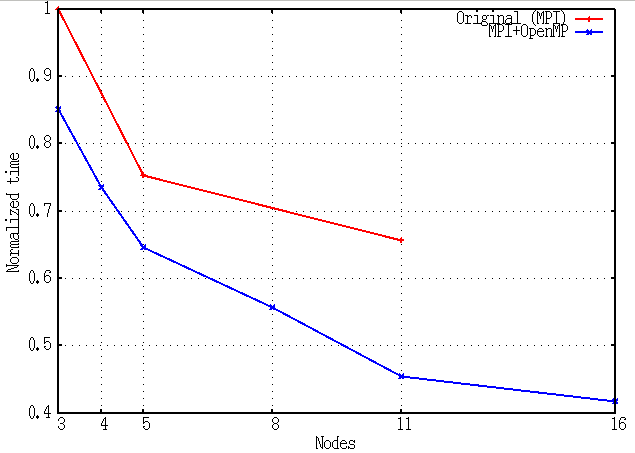ParaDiS with precipitates optimized to HPC environment¶
Discrete dislocation dynamics (DDD) simulations usually treat with “pure” crystals and dislocations in them. In reality, there is a need to look at more complicated scenarios of impurities interacting with the dislocations and their motion. Effects on a single atom / vacancy level may be incorporated by renormalizing the dislocation mobility but in many cases the dislocation dynamics is changed by the presence of clusters or precipitates, that act as local pinning centers. The consequences of the impurities are multiple: the yield stress is changed, and in general the plastic deformation process is greatly affected. Simulating these by DDD allows to look at a large number of issues from materials design to controlling the yield stress and may be done in a multiscale manner by computing the dislocation-precipitate interactions from microscopic simulations or by coarse-graining the DDD results for the stress-strain curves on the mesoscopic scale to more macroscopic Finite Element Method (the material model therein).
This module provides an extension of the ParaDIS DDD code (LLNL, http://paradis.stanford.edu/) where dislocation/precipitate interactions are included. The extension is for an HPC environment, in which the original code has been optimized for the Cray XC40 cluster at CSC in Finland in mind. Vectorizing better some subroutines and using threads better by a combination of MPI and Open MP allows for large-scale jobs speed-ups of a factor of 1.5 and allows to use more computational nodes than what is reasonable with the original version, so that the production time is speeded up by a factor of two. This is visualized in the figure below, where the normalized time is plotted versus the number of nodes for both the original and the HPC optimized codes.

Purpose of Module¶
The method is based on extending a recent version of ParaDIS to handle the presence of pinning centers. These work as localized Gaussian potentials that interact with the near-by dislocations (see A. Lehtinen et al. Phys. Rev. E 93, 013309 (2016)). The “disorder field” is given as an input where the locations of the precipates are given in 3D, and the interactions are parametrized by the impurity strength (which may vary from precipitate to another) and the range of the Gaussian potential (which also may vary). The dislocation dynamics is handled as in ParaDIS in general with an additional force terms that accounts for each dislocation segment for the nearby impurities (a cut-off is applied in the force).
The Module thus allows to study various precipitate fields (density, geometry, strength, interaction range) as desired. In a typical ParaDIS simulation one does a simulation of the response of a dislocation system to a strain/stress protocol. The starting point is a dislocation system, which has been obtained from relaxing a random or patterned configuration under zero external stress until the evolution becomes negligible. In the presence of impurities the customary approach is to do two relaxation steps: first follow the relaxation of dislocation configuration, then add the disorder field to that and re-relax. In the current version apart from HPC-related parallelization-relevant steps the subroutines SegSegForce (segment-to-segment force calculation) and FMSigma2Core2 (force multipole expansion) are well vectorized, and the code now also uses better multiple threads in their context.
Background Information¶
The module version is built on the ParaDIS version 2.5.1 which can be obtained from http://paradis.stanford.edu/ and following the steps outlined there for obtaining the code.
Building and Testing¶
The version offered is built exactly like the normal ParaDIS; the makefiles etc. are for the local CSC system and should be modified for the local environment. To test the ParaDiS build, an example case of a constant strain rate simulation of BCC iron with precipitates is included. The input of the test simulation is in file ParaDiS_test.ctrl, where the output directories and the used number of computational domains need to be defined. The initial dislocation structure is contained in the ParaDiS_test.data as usual and the structure of the file is identical to the files used by default ParaDiS. In addition, the simulation has ~8500 precipitates which are included in the ParaDiS_test.pdata file. This .pdata file has first some domain variables defined similar to .data file, and then the precipitates. These are presented one precipitate per line, and the data columns are as follows: [precipitate tag, position x, y and z, impurity strength, interaction radius, boolean], where the boolean states if the precipitate is active.
The used printing options defined in .ctrl file can be modified. Here, examples of the output property data and restart files are included in run_output folder and the file called ParaDiS_test.out contains the standard output of the test when the simulation system is run for ~1.5e-9 seconds. The restart files are written similarly as in unmodified ParaDiS, except that now the precipitates are also included in corresponding rsXXXX.pdata files. In addition to the property files produced by original ParaDiS, the modified ParaDiS writes also files allepsdot and avalanche. Allepsdot contains columns [simulations time, strain rate tensor element 11, stress tensor element 11,…], and avalanche columns [time, average velocity, plastic strain, applied stress, total dislocation length, integrated strain rate] where the average velocity is calculated as a segment weighted average velocity of dislocations.
The test case is illustrated with three files: ParaDiS_test.out, and two plots, which are: aver_velocity_time.pdf (the resulting average dislocation velocity during the run) and stress_plastic_strain.pdf (yield strain versus applied stres during the run).
Source Code¶
Due to licensing reasons, only the difference between ParaDiS version 2.5.1 files and modified files are submitted, and these files can be found in https://version.aalto.fi/gitlab/csm_open/paradis_version_diffs.git.